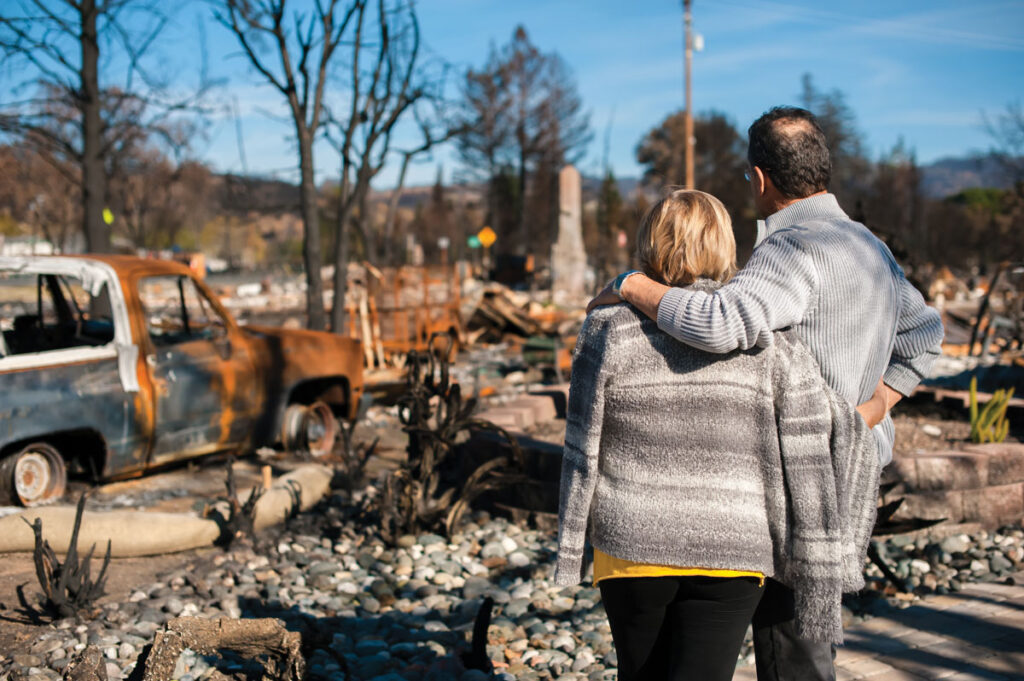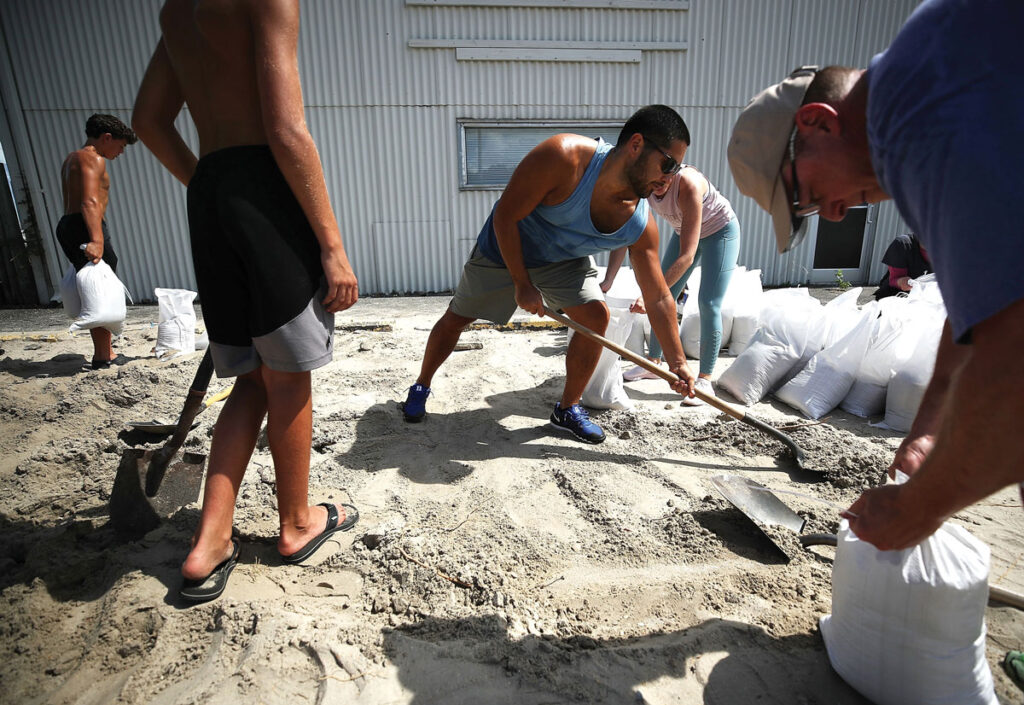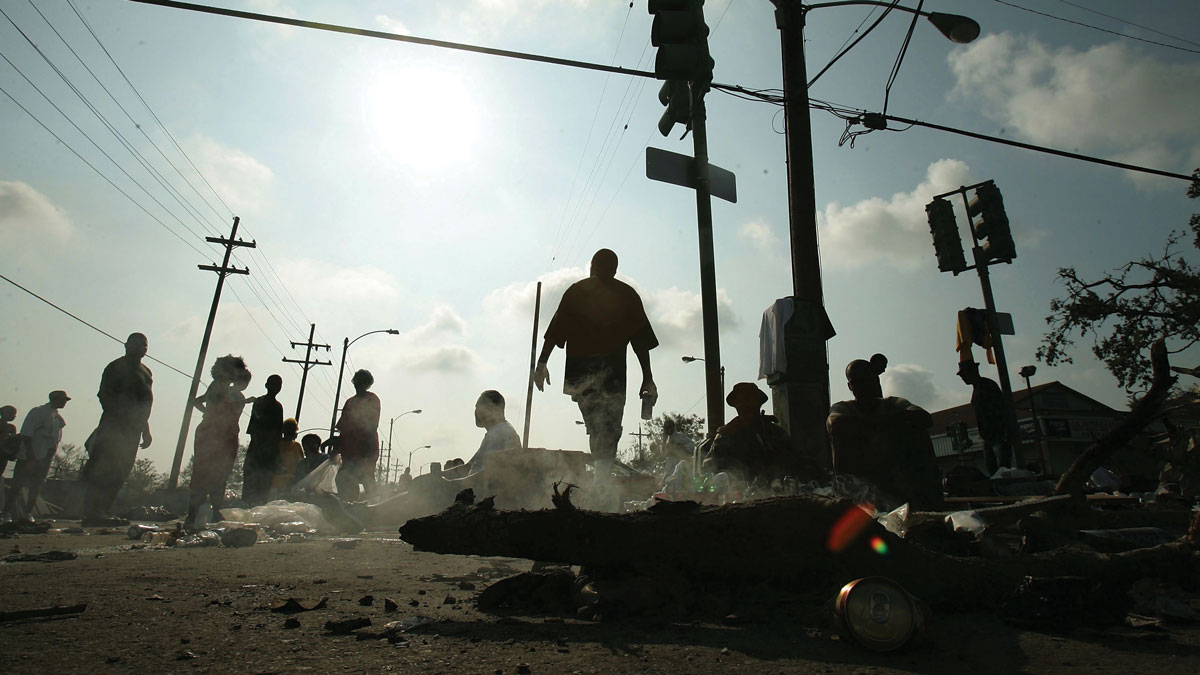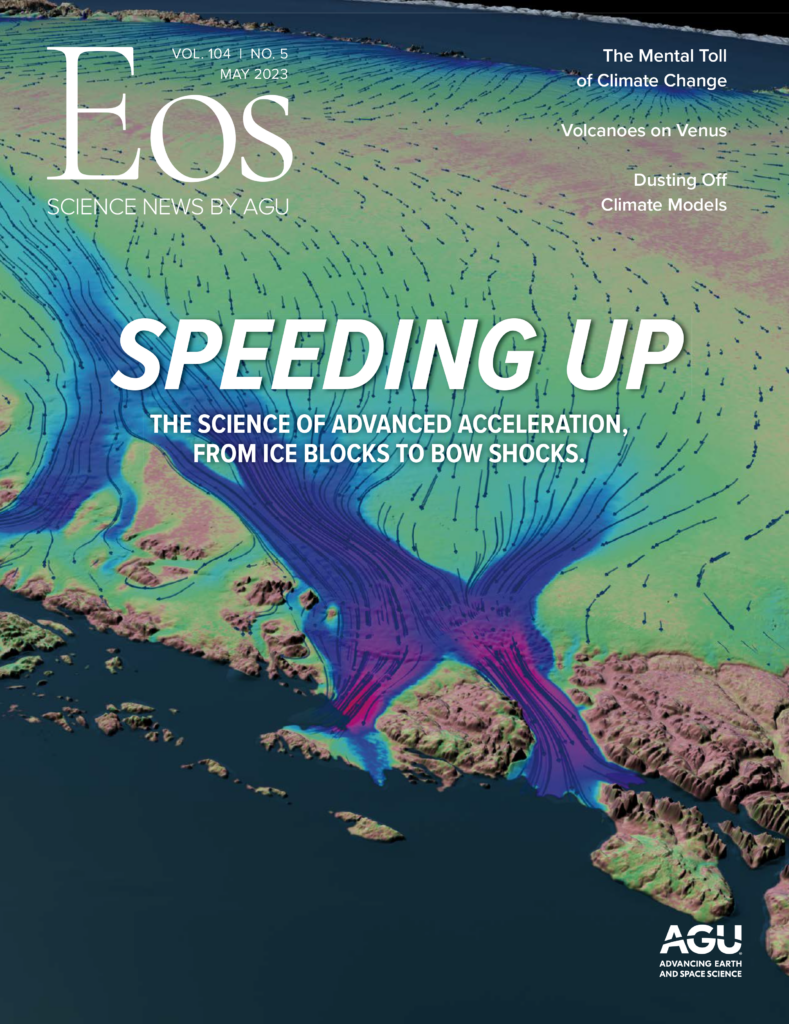A translation of this article was made possible by a partnership with Planeteando. Una traducción de este artículo fue posible gracias a una asociación con Planeteando.
Content warning: This article discusses suicide and potential risk factors of suicide.
Helping people navigate stress brought on by a relationship is standard practice for Megan Irving, a mental health therapist in Oregon. But, Irving and mental health professionals like her are seeing more clients suffering from a wholly different, and perhaps more pervasive, form of stress: unease brought on by the effects of our changing climate.
A growing body of research links the impacts of climate change to adverse mental health outcomes, such as depression, anxiety, post-traumatic stress disorder (PTSD), and substance abuse. But individuals and communities can take steps to bolster their emotional resilience to climate-related stressors, researchers have suggested.
Our physical health can suffer in many ways from the effects of climate change. The most obvious are cases of mortality. In July 2018, an unprecedented heat wave in Japan killed more than a thousand people; researchers later showed that the event could not have happened without climate change [Imada et al., 2019]. And a myriad of nonlethal health issues is apt to worsen because of climate change. For example, respiratory problems have been linked to wildfires, which are increasing in severity and prevalence with climate change, a report concluded [United Nations Environment Programme, 2022].
But beyond the physical maladies brought on or exacerbated by climate change, there’s the potential for a host of mental health issues, said Christie Manning, an environmental psychologist at Macalester College in Saint Paul, Minn. It makes sense that climate change would affect how we feel, said Manning, a coauthor of the “Mental Health and Our Changing Climate” report published by the American Psychological Association, Climate for Health, and EcoAmerica. Its deleterious effects seem to dominate the news, and the issue often seems so intractable and beyond our control, she said. “The individual things we can do feel so incommensurate with the problem.”
The Trauma of Sudden-Onset Events
When it comes to evaluating how our mental functioning is affected by climate change, Manning and other mental health experts have tended to find consistent patterns. “It’s pretty standard these days to think about the mental health impacts in three broad categories,” said Manning.
The first category is brought on by acute events such as devastating storms, wildfires, and floods. Sudden-onset events can cause trauma, which often manifests as PTSD and has been linked to anxiety, major depressive disorder, and substance abuse, said Manning. In 2006, researchers surveyed more than 400 community college students living in the region around New Orleans. All of the study participants had been affected by Hurricane Katrina the year prior, and more than half of them lived in the Ninth Ward, an area that suffered some of the worst destruction from the storm. The researchers found that nearly half met the diagnostic criteria for PTSD [Lowe et al., 2013].
After a slew of destructive wildfires plagued California in October 2017, residents living in affected counties reported feelings of trauma and guilt, in addition to anxiety, depression, and solastalgia (defined as melancholia related to a home environment that has been altered) according to a survey of more than 2,200 households. And that distress persisted over time, the research team found; survey participants reported similar feelings both immediately after the fires and several months later. “We need people to understand that this is not ‘over’ for us,” one respondent wrote. The researchers, led by Mitchell Snyder at the University of California, Davis, reported their results at AGU’s Fall Meeting 2022.
Natural disasters, including floods and hurricanes, have also been linked to increased suicide rates. Jennifer Horney, an epidemiologist at the University of Delaware in Newark, and her colleagues showed that in U.S. counties that experienced a natural disaster, suicide rates increased by 23% in the first 3 years after the disaster compared with the 3 years preceding the disaster [Horney, 2020]. The team reported its results in 2020 in the journal Crisis.
As the climate continues to change, the frequency and intensity of acute events such as wildfires and hurricanes are predicted to increase. Compound disasters—multiple destructive events, such as a mudslide following a fire—are also more likely with climate change, recent research has shown. “Climate change is growing in its physical manifestations,” said Manning. And that means that more people will be exposed to potentially traumatic events, she said. “It’s getting harder and harder not to experience climate change.”
Chronic Conditions

Events that evolve more slowly—and are almost chronic in nature—are responsible for the second category of impacts. Gradual shifts in our environment linked to climate change include prolonged droughts, desertification, and persistent heat waves. Changes in temperature and weather patterns can trigger a sense of uncertainty, said Manning. “It makes people question what’s happening.” Particularly for people who live close to the land—whose identities, cultures, or livelihoods depend on environmental predictability—that uncertainty can escalate to feelings of hopelessness and despair, sometimes with tragic results.
Azar Abadi, a climate epidemiologist at the School of Public Health at the University of Alabama at Birmingham, and her colleagues recently studied the association between drought exposure and risk of suicide in the United States. They found that drought conditions, as estimated using 2000–2018 data from NOAA’s Evaporative Demand Drought Index, were correlated with higher rates of firearm suicide, particularly among nonurban populations. “We found that rural communities are more susceptible,” said Abadi, who shared her team’s findings at AGU’s Fall Meeting 2022. These findings are particularly concerning, said Abadi, because some groups of rural dwellers are already overrepresented in suicide cases compared with the general population.
Researchers have also predicted that the suicide rate in the United States will increase overall as temperatures rise. A team led by Anna Belova, an economist at the consulting firm ICF, considered different global climate models and scenarios corresponding to 1°C–6°C of warming. They showed that up to roughly 1,600 additional suicides could occur each year because of climate change [Belova et al., 2022]. The researchers reported their results in GeoHealth.
Suicide is a tragic manifestation of mental anguish, and it’s important to understand its causes, said Abadi. However, she noted, climate change and mental health are controversial issues, and it can be difficult to engage people in those discussions. “When these two topics are combined, it’s not an easy conversation.” But it’s critical to acknowledge mental distress, said Abadi. “When we talk about well-being, it’s a combination of physical health and mental health.”
Climate Anxiety
The third broad category of climate change–induced mental health impacts is often characterized as lingering and unshakable concern, worry, or anger. Those feelings—sometimes referred to collectively as climate anxiety—are brought on by an awareness that the environment is, perhaps indelibly, changing. And a person doesn’t need to have experienced trauma personally to be affected, said Manning. Instead, the concern, worry, or anger can be “connected to a worry about what is going to happen and what we’ve lost already,” she said.
“People are still anxious and depressed and angry about what they’re seeing play out.”
Of the three categories of climate change–related mental health impacts, climate anxiety most commonly afflicts Irving’s clients. That’s perhaps because people are more cognizant of climate change and its deleterious effects than they were even a decade ago, said Irving, who sees clients in Portland and Rockaway Beach, Ore. Climate anxiety appears to be pervasive: A poll conducted in 2019 on behalf of the American Psychological Association revealed that more than two thirds of Americans suffer from it [American Psychological Association, 2020].
Worry and uncertainty are natural responses to a growing awareness of climate change, even if a person’s cultural identity or livelihood isn’t intimately tied to the environment, said Irving. “People are still anxious and depressed and angry about what they’re seeing play out.”
Angry, Baffled, and Horrified

The responses of younger generations to climate change are often marked by a sense of outrage, Irving said: “Young folks are angry and baffled and horrified that more action isn’t being taken.” Emotions such as anger, shame, grief, and despair are often evident in youth-led protests about climate change. Many youth feel that they’re being forced to grow up in a world where the effects of climate change have already been set in motion by previous generations: A recent survey of 10,000 people aged 16–25 (that is, individuals largely belonging to Generation Z) revealed that more than 80% believe people have failed to take care of the planet [Hickman et al., 2021].
Irving’s generation predates Generation Z, but thinking about climate change and its effects triggered similar emotions for her, she said. “I started feeling anxious,” she said. “I started getting depressed.”
Roughly a decade ago, Irving began looking for resources to support her own mental well-being. Taking care of oneself—”doing the work,” Irving called it—is particularly important for people working on the front lines of mental health: It’s those individuals who are often expected to be strong for others and provide solutions.
While searching for resources to help her process her own climate change–related feelings, Irving discovered the Climate Psychology Alliance, an organization devoted to supporting people experiencing distress resulting from climate change. Irving has since participated in several of the alliance’s climate cafés, which are virtual gatherings open to anyone worried about the climate crisis. The events are facilitated but largely function as open forums for participants to discuss their concerns and meet like-minded people.
Realizing that other people were wrestling with similar feelings was cathartic, said Irving. “I found some relief in knowing that I wasn’t the only one that was feeling this way.”
When Homelands Change
The mental health impacts of the climate crisis do not afflict everyone, nor do they strike in the same way when they do. Researchers have found that communities living close to the land in places where environmental conditions are changing particularly rapidly are often at the highest risk.
One person who knows that well is Ashlee Cunsolo, a health geographer at the Labrador Campus of Memorial University of Newfoundland in Canada. Cunsolo has worked with Inuit communities for more than a decade and has documented the “ecological grief”—a term she coined with colleague Neville Ellis [Cunsolo and Ellis, 2018]—felt by community members as their homelands change.
Seasonal cycles in Nunatsiavut, a self-governing territory of Inuit in Labrador, are largely dictated by the ebb and flow of sea ice. A thick layer of ice means safe conditions for traveling and hunting, but Labrador, like many parts of the Arctic, is warming. It’s one of the fastest warming places in Canada, said Cunsolo. “Labrador has been at the front lines of the changing climate for decades.” As a result of that warming, sea ice is forming later in the year and retreating earlier than it used to; it’s also not growing as thick now as it once did. These days, there are longer stretches of time when it’s not safe to venture out onto the ice.
The feeling of being cooped up weighs on Inuit mental health, Susan Saksagiak, a resident of Nain, the largest community in Nunatsiavut, told Cunsolo. “When people have to stay home longer and longer, it’s hard on the mind.”
In 2013, Cunsolo conducted interviews with Saksagiak and 23 other Inuit individuals for Lament for the Land, a documentary film she created in partnership with the five Inuit communities of Nunatsiavut (lamentfortheland.ca). Again and again, community members shared with Cunsolo their feelings of losing their sense of identity, which in turn negatively affected their mental well-being, as their homeland changed before their eyes. “You lose control of a part of your life,” Derrick Pottle, a resident of Rigolet, the southernmost community in Nunatsiavut, told Cunsolo.
But several years ago, community members came together to fight against the losses they were experiencing: They started developing programs designed to improve the mental health of their youth and bolster their community’s overall resilience. The work was initially motivated by tragedy: In 1 year, seven Nain youth died by suicide. Beyond providing a supportive environment for Inuit youth, community members also sought more opportunities to engage in meaningful cultural connections and cross-generational dialogue.
One of the programs that resulted, Going Off, Growing Strong, engaged Inuit youth in activities like preparing traditional foods, fixing snowmobiles, and doing arts and crafts with elders.
“All of these things make people feel connected to their culture and their ancestors and their family and their community,” said Cunsolo. A sense of connectedness—that is, social support—has been linked to lower levels of psychological distress, research has shown [Banks and Weems, 2014].
“When you have something as scary as climate change, one of the best ways to cope is to find community.”
“We need community,” said Irving. “When you have something as scary as climate change, one of the best ways to cope is to find community.”
The programs developed by people in Nunatsiavut are an example of the positive outcomes of something Cunsolo terms “gritty hope.” Sometimes hope in its barest incarnation can be an excuse for inaction, said Cunsolo, but that’s not the case with gritty hope. “It’s hope that stems from pain and mobilizes action.” Gritty hope is having a mindset of not dwelling on what’s been lost already and being prepared to stave off future losses, said Cunsolo. “We can fight like hell to make sure more isn’t lost.”
Cunsolo engages in her own form of gritty hope. It’s what keeps her going, she said, when her work forces her to watch people suffer as their ancestral lands and ways of life irrevocably change. “It’s like you’re surrounded by the pain of the world all the time,” she said. “It’s a heavy burden to carry.” Cunsolo advocates for policies that recognize the human, mental, and emotional impacts of climate change. Getting the word out about how climate change affects us in so many different ways and connecting with people give her purpose, she said.
Taking Time for Self-Care
Mental self-care in the face of climate change looks different for different people.
Josh Edelson, a freelance photojournalist based in Novato, Calif., regularly photographs wildfires in the Golden State. He can be embedded with a blaze for days at a time, living out of his car and dodging falling trees that are still burning on the inside, all the while shooting images for the Associated Press and the Los Angeles Times, among other news organizations.
Over the roughly 10 years he’s been documenting wildfires, he’s seen them change. “Fires have become bigger and more intense,” said Edelson.
And ever since the 2015 Valley Fire destroyed Middletown, a small town in Northern California near Santa Rosa, blazes have been more likely to tear through inhabited areas, he’s noticed. “Almost every single year thereafter [there] has been a bigger fire with more damage and more destruction.” Those conflagrations leave wakes of destruction of both structures and life, which Edelson has witnessed firsthand.
“We go to the store, and I’m looking around imagining what things would look like on fire.”
After Edelson emerges from covering a blaze, it can take several days for him to feel normal again, he said. Sometimes even everyday events like grocery shopping with his wife can trigger fire flashbacks. “We go to the store, and I’m looking around imagining what things would look like on fire,” he said. “It still echoes in your mind.”
Edelson said he finds it helpful to process his experiences with other people who understand what he’s been through. “I have a core group of other photographers that cover fires,” he said. “We talk with each other a lot, and that’s incredibly therapeutic.”
Seeking support from others is a time-tested way of combating mental health issues, including those triggered by climate change. It’s therapeutic to be understood and validated, and communities can take on a variety of forms ranging from individuals bonded by a shared experience to strangers brought together by a support group. Irving often encourages her clients to seek out people who can relate to their experiences. “I have a growing list of support groups,” she said.
Beyond increasing social cohesion, people can boost their resilience to distress brought on by climate change in other ways. One technique is to develop a practice—otherwise known as a habit or a routine—that gives you strength, said Manning. That might be mediation or mindfulness or involvement in a faith-based community. Or it could be therapy, she added. The Climate Psychology Alliance maintains a directory of more than 100 mental health providers across the United States, Canada, and the United Kingdom who are committed to addressing mental health needs related to climate change.
Individuals can also help themselves and others by learning and practicing the tenets of psychological first aid. This interventionist strategy—designed to help people feel safe, calm, empowered, connected, and hopeful in the aftermath of a disaster—can help reduce the incidence of long-term mental health problems, research has shown [Birkhead and Vermeulen, 2018].
Preparing for the future can furthermore help individuals cope with climate change–related stress, said Manning. Reconfiguring a home to make it more weather and disaster resistant—raising it up on stilts to stave off flooding, for example—can be beneficial to mental health, she said.
But even relatively simple (and less expensive) steps help, too. Putting together a box of emergency supplies stocked with food and first aid items can make people feel more prepared and better able to face an uncertain future, said Manning. “People who do this kind of preparation work feel better and fare better.”
Engaging in positive work that makes a difference is another proven method for bolstering climate change–related resilience: When people help others, their own well-being increases. That’s been shown time and time again, in communities ranging from individuals affected by hurricanes [Spialek et al., 2019] to people affected by flooding [Woodhall-Melnik and Grogan, 2019].
Climate change is altering our lives in fundamental ways, and it’s daunting to think about the environmental and societal shifts that will transpire. But emotional resilience to the effects of climate change can be honed, albeit with dedication and effort.
Perhaps conversations around health—both physical and mental—might be a key to helping people honestly face climate change, said Abadi. “I noticed that when we talk about health, people actually listen,” she said. “Health is the best communication pathway about climate change.”
References
American Psychological Association (2020), Majority of US adults believe climate change is most important issue today, www.apa.org/news/press/releases/2020/02/climate-change.html.
Banks, D. M., and C. F. Weems (2014), Family and peer social support and their links to psychological distress among hurricane-exposed minority youth, Am. J. Orthopsychiatry, 84(4), 341–352, https://doi.org/10.1037/ort0000006.
Belova, A., et al. (2022), Projecting the suicide burden of climate change in the United States, Geohealth, 6, e2021GH000580, https://doi.org/10.1029/2021GH000580.
Birkhead, G. S., and K. Vermeulen (2018), Sustainability of psychological first aid training for the disaster response workforce, Am. J. Public Health, 108, S381–S382l, https://doi.org/10.2105/AJPH.2018.304643.
Cunsolo, A., and N. R. Ellis (2018), Ecological grief as a mental health response to climate change-related loss, Nature Clim. Change, 8, 275–281, https://doi.org/10.1038/s41558-018-0092-2.
Hickman, C., et al. (2021), Climate anxiety in children and young people and their beliefs about government responses to climate change: A global survey, Lancet Planet. Health, 5(12), e863–e873, https://doi.org/10.1016/S2542-5196(21)00278-3.
Horney, J. A., et al. (2020), The impact of natural disasters on suicide in the United States, 2003–2015, Crisis, 42, 328–334, https://doi.org/10.1027/0227-5910/a000723.
Imada, Y., et al. (2019), The July 2018 high temperature event in Japan could not have happened without human-induced global warming, Sola, 15A, 8–12, https://doi.org/10.2151/sola.15A-002.
Lowe, S. R., E. E. Manove, and J. E. Rhodes (2013), Posttraumatic stress and posttraumatic growth among low-income mothers who survived Hurricane Katrina, J. Consult. Clin. Psychol., 81(5), 877–889, https://doi.org/10.1037/a0033252.
Spialek, M. L., J. B. Houston, and K. C. Worley (2019), Disaster communication, posttraumatic stress, and posttraumatic growth following Hurricane Matthew, J. Health Commun., 24(1), 65–74, https://doi.org/10.1080/10810730.2019.1574319.
United Nations Environment Programme (2022), Spreading like Wildfire: The Rising Threat of Extraordinary Landscape Fires, Nairobi, www.unep.org/resources/report/spreading-wildfire-rising-threat-extraordinary-landscape-fires.
Woodhall-Melnik, J., and C. Grogan (2019), Perceptions of mental health and wellbeing following residential displacement and damage from the 2018 St. John River flood, Int. J. Environ. Res. Public Health, 16(21), 4174, https://doi.org/10.3390/ijerph16214174.
Author Information
Katherine Kornei (@KatherineKornei), Science Writer


